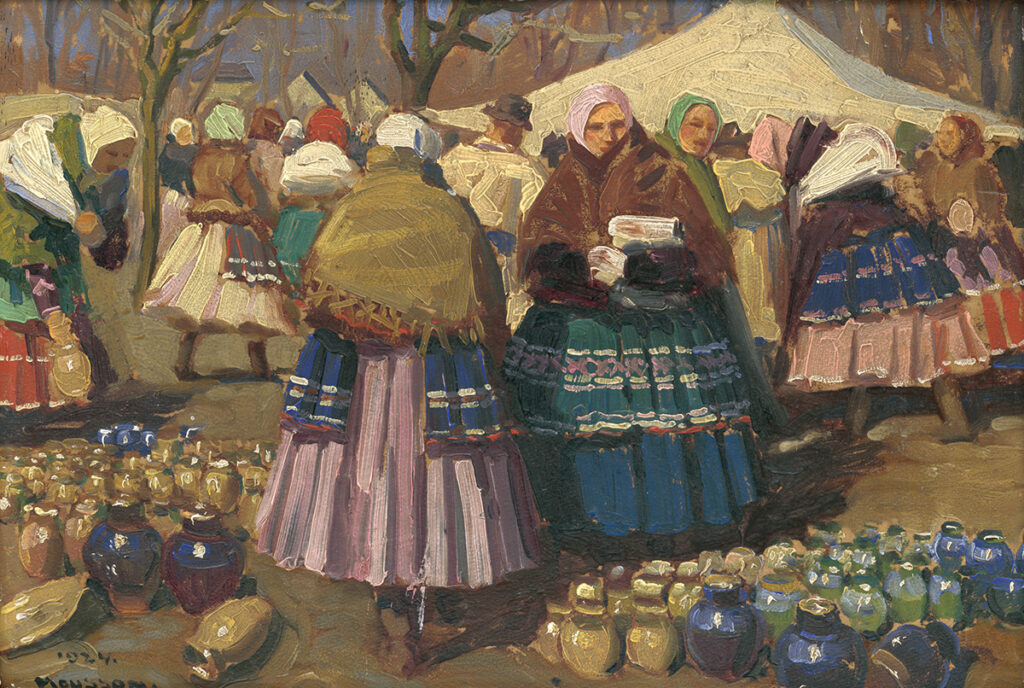“When I got off in the train station in Michalovce I was enchanted by the folk costumes of women glaring with colours.”
—J.T. Mousson, 1911
It was the moment when the art teacher and painter fell in love with the region, atmosphere and people in the area of Zemplín. The author started with landscape painting and used the elements of luminism. Later his landscape painting was characterized by the impressive colour scale that he learned to use during his stay in a colony of painters in Nagybányi.
“Market in Banská Štiavnica” is one of the many genre artworks that he created during his lifetime. The figurative composition depicts the market with a unique atmosphere in late spring, with isolated trees on the background of the blue sky of a rising morning. Village women in short fur coats and plaids with little linen knapsacks on their backs surrounded by clay jugs displayed on the ground offer their products with brown, green and blue décor, typical for the pottery masters from Ľubietová. The pottery was made during winter time and in spring it was sold in markets nearby.
At the first glance it can seem that the scenery is static, however, it is, in fact, very dynamic. The dynamism comes from the women dressed in the folk costumes of vivid even striking colours, they chat, they form groups, they leave, and the whole composition is stirred with movement. The scene is impressive because of the intensity of colours and also because of the play of light. Impasto of colours form a rich radiating scale and create an impressive visual experience. This artwork also documents that the point of departure for Mousson was the reality perceivable by senses. He was able to capture the momentary. It is possible to “hear” also a conversation of two chatting women, in the foreground of the painting, amidst the roaring market place.
Jozef Teodor Mousson was born in Högyészy, Hungary, in 1887. In 1905 -1909 he studied at the Academy of Fine Arts in Budapest (Professor E. Ballo). In 1910 he received the scholarship from the Union of Visual Artists. In 1911 he accomplished a short stay in an artistic colony in Nagybányi (Baia Mare, Romania), where he acquired the basic skills of landscape art. From 1911 he lived permanently in Michalovce. Until 1919 he was an art teacher, then a freelance artist. He visited Italy – Venetia in 1913 as a study stay. In 1931 he moved to a villa in Hrádok near Michalovcem, the admirer of his work, earl A. Sztáray offered the place to him to stay there.
At the end of the twenties and in mid-thirties his painting career culminates. It is characterized by a unique harmony of his expressive signature and decorative impressive colour scale adopted from the richness of folk art in Zemplín. He became a consistent painter – monographer of the ethnographic region of Zemplín, in the east of Slovakia.
He was the member of the art group Kunstverein and the Union of Slovak Visual Artists. In 1942 he suffered a stroke and the left side of his body was paralysed. During WWII, in 1944 he moved to Bratislava and after 1945 he lived in Trenčín at his son’s house where Jozef Teodor Mousson in 1946 died. The author lived almost 33 years of his life in Michalovce. He was called “the painter of Zemplín sun and people“.
— Marta Hučková, August 2013
Bibliography
Váross, M.:Slovenské výtvarné umenie 1918-1945. In: Tvorivé profily. SVKL, Bratislava, 1960, p. 132-133
Kubíková, K.: Teodor Jozef Mousson (1887-1946) – Monografista Zemplína. Bratislava, Slovenská sporiteľňa, 2005
Kiss-Szemán, Z. : Slovenské moderné umenie. Bratislava: Calder s.r.o., 2012, p. 223
Inventory No.: O 1704
Author: Jozef Teodor Mousson
Work Title: Market in Banská Štiavnica
Year of Origin: 1924
Technique: oil
Material: card board
Dimensions: 36 × 49 cm
Marked: in the left bottom corner, by hand, by a paintbrush, MOUSSON 1924
